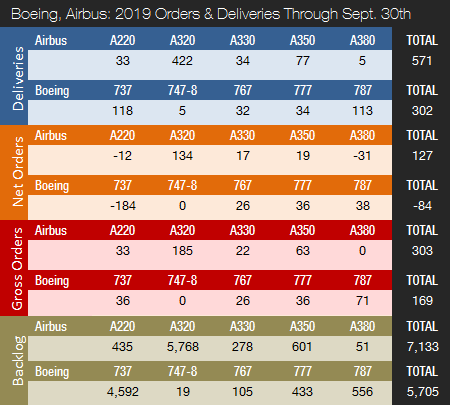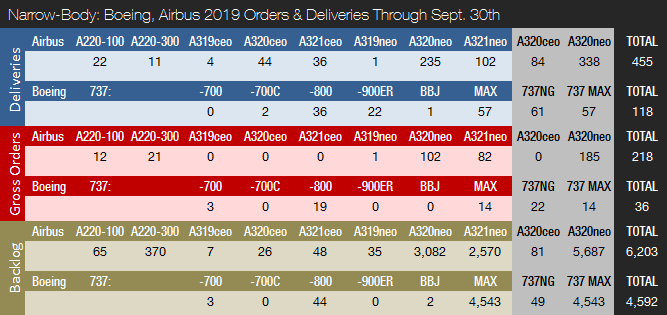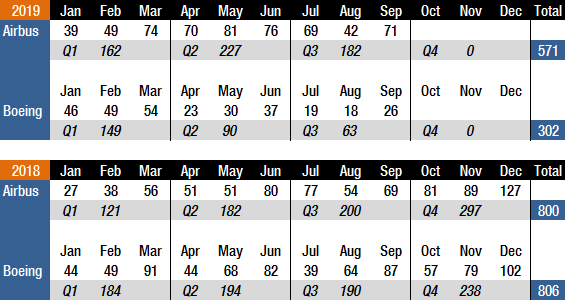737 MAX Technical Review Releases Observations, Findings, and Recommendations
by J. Kasper Oestergaard, European Correspondent, Forecast International.

Boeing and Airbus delivered 26 and 71 commercial jets in September 2019, compared to 87 and 69 deliveries, respectively, in the same month last year. With just 302 deliveries this year to date, Boeing is 266 shipments behind last year’s total for the first three quarters of the year. Airbus delivered a total of 571 jets from January to September, compared to 503 during the same period last year. Boeing’s deliveries have taken a severe hit since the two 737 MAX crashes and the subsequent deliveries halt and grounding of the fleet. Boeing decided in March to suspend all deliveries of 737 MAX jets. The crashes were with a high degree of certainty caused by the aircraft’s Maneuvering Characteristics Augmentation System (MCAS), which suddenly activated in response to erroneous angle of attack information. In 2018, Boeing delivered 806 jets (763 in 2017), with Airbus handing over 800 (718 in 2017).
In September, Boeing delivered two 737NGs. Boeing is still producing 737 MAX jets at a reduced rate of 42 aircraft per month and thereby building up an inventory of aircraft ready to be shipped. During 2018, Boeing raised its 737 production rate to 52 and was planning a further increase to 57 per month from June of this year. Producing the 737 MAX at a reduced rate will allow the company to prioritize additional resources to focus on returning the 737 MAX to flight. In April, the U.S. Federal Aviation Administration (FAA) established a Boeing 737 MAX Joint Authorities Technical Review (JATR) comprising a team of experts from the FAA, NASA, and international aviation authorities. Since then, Boeing has worked with the FAA and the JATR and has tested updates to its 737 MAX software during hundreds of flights.
On September 19, Boeing hosted FAA Administrator Steve Dickson at its narrowbody assembly facilities in Renton and Seattle. Steve Dickson spent time in the 737 MAX simulator and held discussions with senior Boeing leaders. On September 25, Boeing announced the creation of a permanent Aerospace Safety Committee of the Board of Directors. Boeing also presented its recommendations from a five-month independent review of its policies and processes for airplane design and development. On September 26, the National Transportation Safety Board (NTSB) presented its findings and recommendations to the FAA, criticizing Boeing for failing to adequately consider how pilots respond to cockpit emergencies in its 737 MAX safety assessment.
On September 30, Boeing CEO Dennis Muilenburg announced that Boeing is approaching the “endgame” of preparing the 737 MAX to return to service. Currently, the company is fine-tuning a software upgrade for the MAX’s flight-control computers in its simulation lab. According to Muilenburg, this is the final hurdle before the FAA determines if the ban can be lifted.
On October 11, the JATR submitted its observations, findings, and recommendations. In its report, the JATR criticizes both Boeing and the FAA for how they assessed and approved the design of the 737 MAX’s automated flight-control system.
Exactly when the 737 MAX will return to service remains unclear, however. Boeing’s best estimate is that the jet could be approved “early in the fourth quarter.” The largest operator of the grounded jet, Southwest Airlines, has canceled all 737 MAX flights through early January. In total, Boeing has delivered 387 737 MAX jets to date. A total of 256 737 MAX jets were delivered in 2018, up from 74 in 2017. In September, Boeing also delivered one 747, four 767s, seven 777s, and 12 787s. Boeing recently raised the monthly Dreamliner production rate to 14 aircraft. Boeing has handed over 113 787s year-to-date. The company delivered 145 787s in 2018, up from 136 in 2017. In connection with Boeing’s second quarter 2019 earnings report, CEO Dennis Muilenburg announced that Boeing plans to increase 777F production due to 777X delays, but did not disclose by how much.
In September, Airbus delivered seven A220s, 48 A320s (8 CEO / 40 NEO), four A330s, and 12 A350s. Airbus recently increased the official A320 production rate to 60 aircraft per month and is targeting an additional raise to 63 jets per month from 2021. A total of 386 A320neo family aircraft were delivered in 2018, up from 181 and 68 in 2017 and 2016, respectively. Airbus has delivered 77 A350s year-to-date, having shipped 93 A350s in 2018 – up from 78 in 2017 – and recently increased the monthly production rate to 10. Airbus is considering a further increase to 13 A350s per month, but a date has yet to be announced. With the ramp-up of A350 XWB deliveries combined with a higher A320 production rate, Airbus has nearly eliminated Boeing’s deliveries lead in recent years. Following the tragic 737 MAX events, Airbus is almost certain to deliver more aircraft than Boeing in 2019.
Turning to the orders race, Boeing had a mixed month in September, logging 25 gross orders. They were a combination of 767 and 787 widebody jets, as well as one 737 MAX narrowbody (23 cancellations => net of two). Boeing’s September bookings included 15 767-2Cs for the U.S. Air Force’s KC-46 Tanker program as well as eight 787-10s for Air New Zealand, a 737 MAX for a bizjet customer, and a single 767-300F for an undisclosed customer. Year-to-date, Boeing has accumulated 169 gross orders (253 cancellations => -84 net new orders). For full-year 2018, Boeing booked 893 net new orders (1,008 gross orders).

In September, Airbus booked 41 gross orders and reported nine cancellations, resulting in 32 net new orders. Undisclosed customers ordered a mix of 14 A220s, while AerCap ordered five A320neos. Another undisclosed customer placed an order for 10 A321neos. Finally, Air Asia X firmed up an order for 12 A330-900s. For 2019 to date, Airbus reports 303 gross orders (176 cancellations => net of 127). Of these cancellations, 31 were due to Emirates’ decision earlier this year to reduce its A380 order book. This subsequently forced Airbus to announce that it will cease A380 production in 2021. In 2018, Airbus landed a total of 747 net new orders (831 gross orders), thereby losing the 2018 orders race since Boeing had accumulated 893 net new orders. Airbus had retained an orders lead over its rival every year since 2012.
On September 30, Airbus’ backlog was 7,133 jets, of which 6,203, or 87 percent, were A220 and A320ceo/neo family narrowbodies. The company’s all-time backlog record high of 7,577 jets was set in December 2018. By the end of September 2019, Boeing’s backlog (total unfilled orders before ASC 606 adjustment) was 5,705 aircraft, of which 4,592, or 80 percent, were 737 NG/MAX narrowbody jets. Boeing’s all-time backlog high of 5,964 aircraft was set in August 2018. The number of Airbus aircraft to be built and delivered represents 8.9 years of shipments at the 2018 production level. In comparison, Boeing’s backlog would “only” last 7.1 years. This year to date, Boeing’s book-to-bill ratio, calculated as orders divided by deliveries, is negative because cancellations have outpaced orders. Airbus’ book-to-bill ratio is 0.22. In 2018, Boeing boasted a book-to-bill ratio of 1.11, with Airbus at 0.93. In 2017, Boeing booked 912 net new orders, for a book-to-bill ratio of 1.20. That same year Airbus booked 1,109 net new orders, for a book-to-bill ratio of 1.54.
New Airbus Long-Term Demand Forecast
On September 18, Airbus released an updated long-term demand forecast calling for 39,000 new aircraft to be built over the next 20 years. According to Airbus, the global passenger and freighter aircraft fleet is set to more than double from nearly 23,000 today to almost 48,000 by 2038, with traffic growing at 4.3 percent annually. This demand will result in a need for 550,000 new pilots and 640,000 new technicians.
2019 Forecast
Forecast International’s Platinum Forecast System® is a breakthrough in forecasting technology. Among many other features, Platinum provides 15-year production forecasts. The author has used the Platinum Forecast System to retrieve the latest delivery forecasts and, for 2019, Forecast International’s analysts expect Boeing and Airbus to deliver 727 and 867 large commercial jets, respectively. The forecast 2019 total for Boeing was 904 prior to the second 737 MAX crash and the subsequent grounding of the fleet and temporary cut in the production rate. These are the latest “live” forecast figures (adjusted frequently by FI analysts as new information comes in). These figures exclude militarized variants of commercial platforms such as Boeing’s P-8 Poseidon, KC-46 and KC-767 tankers, and C-40; and Airbus’ A330 MRTT tanker.
Prior to the second 737 MAX crash, Boeing announced, in connection with the release of its 2018 earnings report in late January, that it was targeting between 895 and 905 commercial jet deliveries in 2019, a 12-13 percent increase from 2018. Boeing has yet to announce a revised figure and is likely awaiting the 737 MAX’s return to service before providing updated guidance. On February 14, Airbus announced that it aims for 880 to 890 commercial aircraft deliveries in 2019, equal to a 10-11 percent increase from 2018.




Note: Boeing 777-300ER orders include one 777-200LR. The 777-300ER backlog includes two 777-200LRs.


Joakim Kasper Oestergaard is Forecast International’s AeroWeb and PowerWeb Webmaster and European Editor. In 2008, he came up with the idea for what would eventually evolve into AeroWeb. Mr. Oestergaard is an expert in aerospace & defense market intelligence, fuel efficiency in civil aviation, defense spending and defense programs. He has an affiliation with Terma Aerostructures A/S in Denmark – a leading manufacturer of composite and metal aerostructures for the F-35 Lightning II. Mr. Oestergaard has a Master’s Degree in Finance and International Business from the Aarhus School of Business – Aarhus University in Denmark.
References:
- http://www.boeing.com/commercial/#/orders-deliveries
- https://www.airbus.com/aircraft/market/orders-deliveries.html
- https://www.faa.gov/news/updates/?newsId=93206
- https://www.boeing.com/commercial/737max/737-max-update.page
- https://www.bloomberg.com/news/articles/2019-09-30/boeing-unveils-revamp-to-deepen-safety-focus-after-max-crashes
- https://boeing.mediaroom.com/2019-09-30-Boeing-Chairman-President-and-CEO-Dennis-Muilenburg-Announces-Changes-to-Sharpen-Company-Focus-on-Product-and-Services-Safety
- http://www.boeing.com/resources/boeingdotcom/commercial/737max/assets/10-fundamental-changes.pdf
- https://boeing.mediaroom.com/2019-09-25-Boeing-Chairman-President-and-CEO-Dennis-Muilenburg-and-Boeing-Board-of-Directors-Reaffirm-Companys-Commitment-to-Safety
- https://news.yahoo.com/1-boeing-did-not-adequately-185601071.html
- https://boeing.mediaroom.com/2019-09-25-Boeing-and-Air-New-Zealand-Finalize-Order-for-Eight-787-10-Dreamliner-Jets
- https://www.faa.gov/news/media/attachments/Final_JATR_Submittal_to_FAA_Oct_2019.pdf
- https://www.seattletimes.com/business/boeing-aerospace/international-regulator-report-slams-boeing-faa-over-737-max-design-and-approval/
- https://www.airbus.com/newsroom/press-releases/en/2019/09/airbus-forecasts-need-for-over-39000-new-aircraft-in-the-next-20-years.html
- https://www.airbus.com/aircraft/market/global-market-forecast.html
A military history enthusiast, Richard began at Forecast International as editor of the World Weapons Weekly newsletter. As the Internet grew in importance as a research tool, he helped design the company's Forecast Intelligence Center and currently coordinates the EMarket Alert newsletters for clients. Richard also manages social media efforts, including two new blogs: Defense & Security Monitor, covering defense systems and international issues, and Flight Plan, which focuses on commercial aviation and space systems. For over 30 years, Richard has authored the Defense & Aerospace Companies, Volume I (North America) and Volume II (International) services. The two books provide detailed data on major aerospace and defense contractors. He also edits the International Contractors service, a database that tracks all the contractors involved in the programs covered in the FI library. More recently he was appointed Manager, Information Services Group (ISG), a new unit that encompasses developing outbound content for both Forecast International and Military Periscope.




